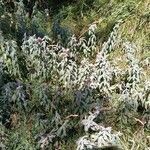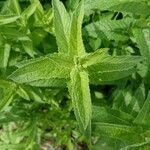Plants rhizomatous, perennial. Stems erect, to 1 m, much branched, whitish, striate, retrorse short tomentose-villous. Leaf blade ovate to oblong-lanceolate, to 6 × 1.5 cm, appressed tomentose-villous, subglabrescent, base rounded to shallow cordate, margin coarsely irregular serrate-dentate, apex acute. Verticillasters in cylindric terminal spikes 3-8 cm, lower ones somewhat lax; floral leaves linear-subulate, mostly shorter than verticillasters. Pedicel to 2 mm. Calyx campanulate, ca. 2 mm, tomentose-villous, obscurely 5-veined; teeth linear-subulate, ca. 1 mm, close together in fruit. Corolla purplish, ca. 4 mm, sparsely puberulent; tube ca. 2 mm, gradually dilated upward; lobes oblong, obtuse; upper lobe oblong-ovate, emarginate. Ovary glabrous. Fl. Jul-Sep.
Perennial, rhizomatous herb, up to 1.5 m high; retrorse-tomentose. Leaves sessile or subsessile, linear-lanceolate to lanceolate, base truncate to obtuse, apex acuminate, margins entire to shortly and distantly toothed; fairly densely to densely pubescent on one or both surfaces; glabrous to variously pubescent. Inflorescences usually of many verticils, often lax below, dense above; rachis usually densely retrorse-tomentose; bracteoles linear. Flowers white to mauve; pedicels hispid. Calyx tubular-campanulate, densely to sparingly glandular-hispid. Corolla 3-5 mm long. Stamens exserted or occasionally abortive. Flowering time Nov.-Apr.
A herb which keeps growing from year to year. It has rhizomes or underground stems. The above ground stems are erect, or creeping and 1 m high. There are many branches. The branches are white with lines along them. The leaf blade is oval to oblong and 6 cm long by 1.5 cm wide. The leaves have teeth along the edge. The flowers are in spikes 3-8 cm long. They are purplish.
Straggling, aromatic shrublet, up to 1.5 m tall, usually coarsely hairy. Leaves sessile, lanceolate, sometimes sparsely toothed. Flowers crowded in spike-like, terminal verticils, white to mauve, calyx 5-toothed.
Straggling, aromatic shrublet to 150 cm, usually coarsely hairy. Leaves sessile, lanceolate, sometimes sparsely toothed. Flowers crowded in spike-like, terminal verticils, white to mauve.












